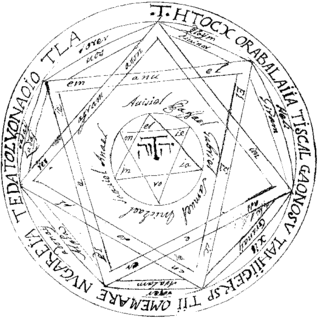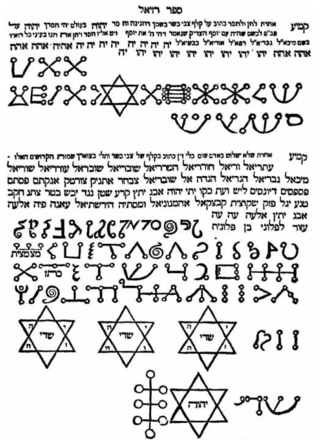Related Research Articles
The occult is a category of esoteric or supernatural beliefs and practices which generally fall outside the scope of organized religion and science, encompassing phenomena involving a 'hidden' or 'secret' agency, such as magic and mysticism. It can also refer to paranormal ideas such as extra-sensory perception and parapsychology.
Thaumaturgy, derived from the Greek words thauma (wonder) and ergon (work), refers to the practical application of magic to effect change in the physical world. Historically, thaumaturgy has been associated with the manipulation of natural forces, the creation of wonders, and the performance of magical feats through esoteric knowledge and ritual practice. Unlike theurgy, which focuses on invoking divine powers, thaumaturgy is more concerned with utilizing occult principles to achieve specific outcomes, often in a tangible and observable manner. It is sometimes translated into English as wonderworking.

Ceremonial magic encompasses a wide variety of rituals of magic. The works included are characterized by ceremony and numerous requisite accessories to aid the practitioner. It can be seen as an extension of ritual magic, and in most cases synonymous with it. Popularized by the Hermetic Order of the Golden Dawn, it draws on such schools of philosophical and occult thought as Hermetic Qabalah, Enochian magic, Thelema, and the magic of various grimoires. Ceremonial magic is part of Hermeticism and Western esotericism.

The Key of Solomon, also known as The Greater Key of Solomon, is a pseudepigraphical grimoire attributed to King Solomon. It probably dates back to the 14th or 15th century Italian Renaissance. It presents a typical example of Renaissance magic.

Meggan Puceanu is a fictional superhero appearing in American comic books published by Marvel Comics, usually as a supporting character in stories featuring Captain Britain, and the X-Men. A mutant empath and shapeshifting elemental, she was created by writer Alan Moore and artist Alan Davis, and first appeared in Mighty World of Marvel #7, which was published in the United Kingdom by Marvel's British publication arm, Marvel UK. Her first appearance in an American Marvel publication was in The New Mutants Annual #2 (1986). She eventually chose the codename Gloriana, a name of victory coined by the demons of Hell.
The Emerald Tablet, the Smaragdine Table, or the Tabula Smaragdina is a compact and cryptic Hermetic text. It was a highly regarded foundational text for many Islamic and European alchemists. Though attributed to the legendary Hellenistic figure Hermes Trismegistus, the text of the Emerald Tablet first appears in a number of early medieval Arabic sources, the oldest of which dates to the late eighth or early ninth century. It was translated into Latin several times in the twelfth and thirteenth centuries. Numerous interpretations and commentaries followed.

Baron Karl Amadeus Mordo is a character appearing in American comic books published by Marvel Comics, commonly as an adversary of Doctor Strange. The character was created by writer Stan Lee and artist Steve Ditko, and first appeared in Strange Tales #111. Baron Mordo is a gifted magician, especially adept in the black arts of magic, including summoning demons.

Doctor Anthony Druid, also known as Doctor Droom and Druid, is a fictional mystic and a supernatural monster-hunter appearing in American comic books published by Marvel Comics. Co-created by writer-editor Stan Lee and penciller Jack Kirby, he debuted as Dr. Anthony Droom in Amazing Adventures #1, published in March 1961. Kirby's art was inked by artist Steve Ditko. Dr. Droom appeared in four more issues of Amazing Adventures before his stories discontinued. Over a year later, artist Steve Ditko approached Stan Lee with a new magic character called Mr. Strange. Liking the idea, Stan Lee renamed the character Dr. Strange and wrote an origin story similar to Dr. Droom's. Dr. Anthony Droom was finally reintroduced to comics in 1976 in Weird Wonder Tales #19 in a retelling of his origin story which renamed him Dr. Anthony Druid. This retelling included new writing by Larry Lieber.
Paradoxography is a genre of classical literature which deals with the occurrence of abnormal or inexplicable phenomena of the natural or human worlds. The term paradoxographos (paradoxographer) was coined by Tzetzes.
Sex magic is any type of sexual activity used in magical, ritualistic or otherwise religious and spiritual pursuits. One practice of sex magic is using sexual arousal or orgasm with visualization of a desired result. A premise posited by sex magicians is the concept that sexual energy is a potent force that can be harnessed to transcend one's normally perceived reality.

Agatha Harkness is a character appearing in American comic books published by Marvel Comics. Created by writer Stan Lee and artist Jack Kirby, the character first appeared in Fantastic Four #94. Agatha Harkness is a powerful witch and one of the original witches from the Salem witch trials. The character debuted as the governess of Franklin Richards and as an ally of the Fantastic Four. She trained the Scarlet Witch / Wanda Maximoff in the art of magic. She is the mother of the supervillain Nicholas Scratch. Agatha Harkness has also been a member of the Daughters of Liberty. Initially an elderly woman, she managed to become young again and increased her strength.

Sefer Raziel HaMalakh is a grimoire of Practical Kabbalah from the Middle Ages written primarily in Hebrew and Aramaic. Liber Razielis Archangeli, its 13th-century Latin translation produced under Alfonso X of Castile, survives.

Morgan le Fay is a supervillain appearing in American comic books published by Marvel Comics. The character, created by Stan Lee and Joe Maneely, is based on the Morgan le Fay of Arthurian legend. In this version of the character, Morgan le Fay belongs to the species of humanoid magical beings called fairies, who are born with supernatural powers, and is the half-faerie half-sister of the mythic King Arthur. Her elven heritage granted her immortality, and she used this time to master the mystic arts. She occasionally tries to take over the world. She has been an opponent of The Avengers, and in the 1970s, she appeared in the original Spider-Woman comic acting as a foe of Jessica Drew, while opposed by a reincarnation of her "ancient foe" Magnus. She is a former lover of Doctor Doom, and was a member of the Darkholders for a time.

Magic in the Greco-Roman world – that is, ancient Greece, ancient Rome, and the other cultures with which they interacted, especially ancient Egypt – comprises supernatural practices undertaken by individuals, often privately, that were not under the oversight of official priesthoods attached to the various state, community, and household cults and temples as a matter of public religion. Private magic was practiced throughout Greek and Roman cultures as well as among Jews and early Christians of the Roman Empire. Primary sources for the study of Greco-Roman magic include the Greek Magical Papyri, curse tablets, amulets, and literary texts such as Ovid's Fasti and Pliny the Elder's Natural History.
De mirabilibus urbis Romae, preserved in a single manuscript in Cambridge, England, is a medieval guide in Latin to the splendours of Rome, which was written in the mid-twelfth century by a certain Magister Gregorius of Oxford. The outlook here is even more secular than the Mirabilia urbis Romae, Roberto Weiss noted. Gregorius spent much of his time describing and even measuring the Roman ruins, and, according to Erwin Panofsky "had yielded so thoroughly to the 'magic spell' of a beautiful Venus statue that he felt compelled to visit it time and again in spite of its considerable distance from his lodgings". Magister Gregorius is the first to take notice of the Roman bronze called the "Spinario", then among ancient bronzes at the Lateran. Panofsky included Magister Gregorius's little book among examples of the reawakening of interest in classical antiquities evinced by a handful of connoisseurs in twelfth-century Rome. Still, like most of his contemporaries raised in familiarity with the Gothic hand, the unfamiliar Roman letters in inscriptions sometimes eluded his translation.

Petit Albert is an 18th-century grimoire of natural and cabalistic magic. It may have been inspired by the writings of Albertus Parvus Lucius. Brought down to the smallest hamlets in the saddlebags of peddlers, it represents publishing success, despite its association with "devil worshipers"—or rather because of it. It is associated with a second work, the Grand Albert. It is a composite, heterogeneous work, collecting texts written by various authors; most of these authors are anonymous but some are notable such as Cardano and Paracelsus. Due to its historical nature, Albertus Magnus' attribution to the text is considerably uncertain and since the text quotes from many later sources, it is an ethnological document of the first order.

Johannes van Heeck,, was a Dutch physician, naturalist, alchemist and astrologer. Together with Prince Federico Cesi, Anastasio de Filiis and Francesco Stelluti, he was one of the four founding members of the Accademia dei Lincei, the first learned society dedicated to understanding of the natural world through scientific enquiry.

The Grand Albert is a grimoire that has often been attributed to Albertus Magnus. Begun perhaps around 1245, it received its definitive form in Latin around 1493, a French translation in 1500, and its most expansive and well-known French edition in 1703. Its original Latin title, Liber secretorum Alberti Magni de virtutibus herbarum, lapidum et animalium quorumdam, translates to English as "the book of secrets of Albert the Great on the virtues of herbs, stones and certain animals". It is also known under the names of The Secrets of Albert, Secreta Alberti, and Experimenta Alberti.
Pseudo-Albertus or Pseudo-Albert is a term referring to the authors of works falsely ascribed to Albertus Magnus. Such works include:

The Kitāb al-nawāmīs is an Arabic book of magic written in the late ninth century in a Ṣābian milieu. It falsely claims to be a work of Plato. The complete Arabic text does not survive, but a complete Latin translation of the twelfth century does, going under the title Liber vaccae or the Book of the Cow.
References
- 1 2 3 4 5 6 Michael R. Best and Frank H. Brightman, eds., The Book of Secrets of Albertus Magnus: Of the Virtues of Herbs, Stones, and Certain Beasts, also a Book of the Marvels of the World (Oxford: Clarendon Press, 1973), pp. xii–xiv.
- 1 2 3 Adam Gwyndaf Garbutt, Assessing the Exotic: Authority, Reason, and Experience in the Construction of Medieval Natural Knowledge, PhD diss. (University of Toronto, 2018), pp. 147–178.